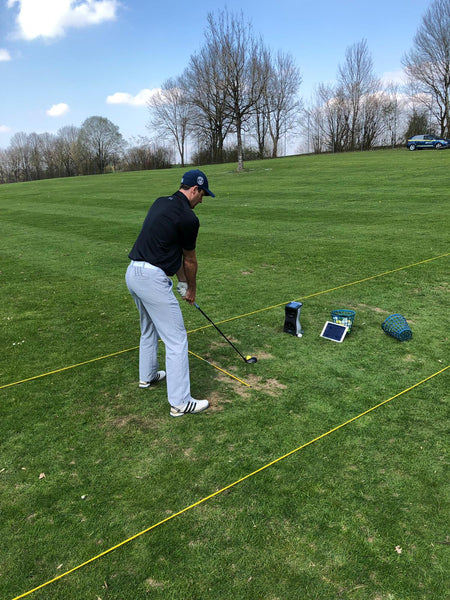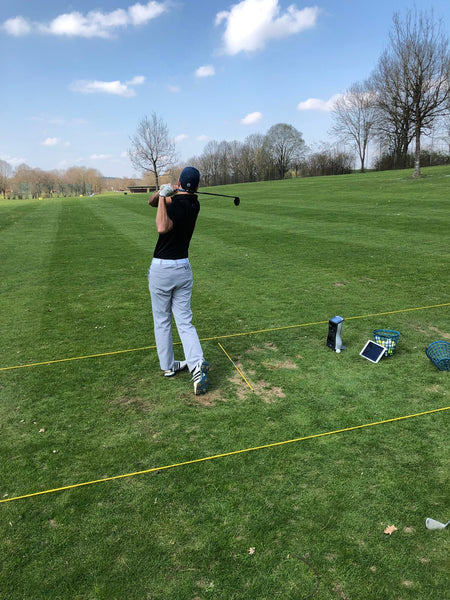Driving Iron vs. Hybrid: Pros and cons in action
So-called utility irons or driving irons are in increasing demand and the manufacturers are also constantly expanding their range of products. It has been shown that such a club makes a lot of sense for a certain group of players. Especially for those who have little to do with a hybrid and need a kind of "gap filler" between irons and fairway woods. Then again, there are players who have to choose between hybrid and driving iron and for whom both are possible alternatives. So it is all the more important to take a closer look at this issue. Let's first look at the theoretical differences:
The Head Design
The most obvious difference is of course the shape itself. A driving iron is still an iron that is cast or forged, for example. For our test we used a forged driving iron made of soft steel. A driving iron usually has a longer clubface than normal irons and considerably more mass in the sole. With modern driving irons you get the maximum support and it plays much easier than a "normal" long iron. This is why many players are now replacing their long irons with driving irons (or hybrids) - even on the tour.
A hybrid, on the other hand, tends to be a smaller and more compact fairway wood. The interior is hollow and the sole is maximally wide. However, the clubface itself does not have to be larger than that of a driving iron - on the contrary. It is usually not quite as long.
The Clubface
An important difference is the fact that the face of a driving iron is straight and not "curved". The face of the hybrid, on the other hand, is convex. The idea behind this, as with drivers and woods, is simply that the clubface will counteract the impact of balls hit outside the sweet spot. If you hit the ball e.g. at the toe, the curved face makes sure that the face direction is more "open" to compensate the left tendency by the so-called "gear effect". This is also the case with thin hits that provide less loft than higher hits. With these the launch is flatter to compensate for the additional spin. So the curved construction has advantages in principle, but not only as we will see later.
Setup of the test
Our goal was to make everything comparable as good as possible. Hybrid and Driving Iron both had exactly 20°, the lie was identical and the shaft for both was the KBS TGI 85 X. The swing weight was also balanced. This is a fair comparison, because the only difference in this test was the club head.
Our test: Hybrid vs. Driving Iron off the deck
Our aim was to hit a green 210m away with both clubs. A quite sporty task that both clubs have to be able to cope with. A very helpful shot for long par 3s or par 5s. Let's have a look at the values:

Both clubs were hit with a clubhead speed of 96mph and an efficiency of 1.40. The ball speed is practically identical and there are only two differences, but these are very important.
Launch and spin
The Driving Iron launched at 11.5°, which is significantly lower than the hybrid's 13.8°. With the spin the result was exactly the opposite: 3800rpm with the driving iron and 4500 with the hybrid. Basically one can say that a driving iron launches flatter and produces less spin.
But everything else would have been surprising, because the hybrid is already designed for more launch and more spin. Interesting is also the fact that the dynamic loft with the driving iron is lower. Our test player intuitively adapted to the club and deliberately played the driving iron a little steeper. This can also be seen on the Angle of Attack. The hybrid allows a slightly flatter swing with the head shape alone and requires less "compression".
Conclusion of the "off the deck" comparison
It is not surprising that the driving iron produces a flatter launch, less spin and therefore a flatter trajectory. In terms of carry length it flies a little further - which is mainly due to the lower spin. However, this also has its disadvantages, because it makes it a bit more difficult to play the green. Less spin and a flatter angle of descent is not ideal. However, this is relative and very individual. Some players can also control a green shot with less than 4000rpm. And here, playing skills are also important. For example, if I manage to play the driving iron with a cut and more spin on the green, I can achieve the same values as with the hybrid. Then again, flags can be played very well.
There are various reasons why the majority of tour pros are currently tending towards driving irons. This is one of them. The other reason is that most hybrids are equipped with a lot of offset. Especially contract players have to resort to the hybrid that is currently on the market from the manufacturer. Offset, however, is something that hardly any tour player needs or appreciates. Rather, it ensures that a draw tendency is exacerbated, something that only very few tour players can use.

Driving Iron vs. Hybrid from the tee
It looks a little different again from the tee. But here, too, the same tendency applies: the hybrid produces more spin at a higher launch. Here the values are 13.1° vs. 14° and 4140rpm vs. 4780rpm. That is quite a difference. The task of our test player was to get the ball onto the fairway in as controlled a way as possible and to achieve a decent length. In this respect the differences were marginal. The test player hit the hybrid a bit better, the ball speed was 4mph higher. But due to the higher launch and the high spin, almost identical distances were achieved.
So our player produced basically the same result although he hit the ball much worse in this test with the driving iron. It is also the case that you notice the differences in the head construction off the tee. A hybrid is able to achieve higher ball speeds.
Our recommendation: Driving Iron or Hybrid?
There are many factors to consider when deciding and the most important ones are the following:
- A hybrid generates more spin and a higher launch
- Attacking the green with the driving iron is much more difficult than with the hybrid
- Hybrids usually have more offset than driving irons. This is not optimal for draw-heavy players
- Driving irons fly flatter and are easier to control, especially in windy conditions
The following is added: A hybrid "corrects" misses better than a driving iron because of the curved face. With this, the "gear effect" is at least somewhat compensated for. This also applies to balls that are hit further down or up on the hitting surface. This means for example: if the ball is a bit higher in the semi-rough and is therefore hit high on the face, the hybrid produces a very high launch but at the same time only minimal spin - similar to the driver. Such a ball then quickly becomes a "flyer" and is hardly controllable. A driving iron produces a more constant launch and spin, so that the variance is less with vertical deviations.
If in doubt, our recommendation would be to go for a hybrid if you know that you can handle or actually need a little more offset. As far as offset is concerned, all models are different and there are certainly Driving Irons with a lot of offset. With a hybrid you should always be aware of the strengths and weaknesses of the curved clubface. In many cases it can help, but in others it can make life more difficult. If you play mostly on soft courses with little wind, you should tend towards the hybrid. If you need the club off the tee more often to produce flat, controlled but long shots, you should tend to use driving iron.
 |
Who are we and why are we doing these tests? - Find out more about us and our fitting philosophy. And also why we are exclusively working with Japanese brands with the highest quality standards. |
 |
Take a look at the Honma TW747 Driving Iron we used for this test - We also reviewed it after playing on the course for several months. |


